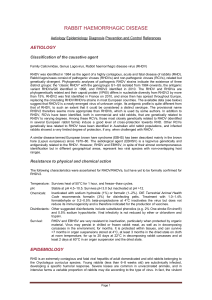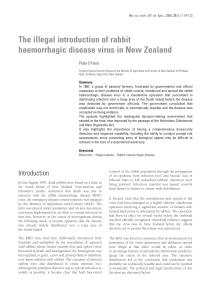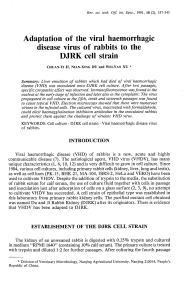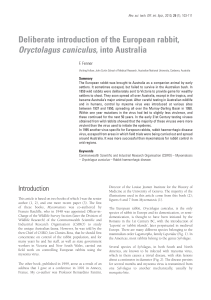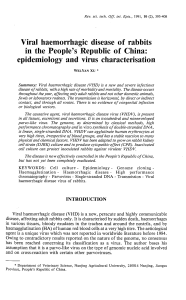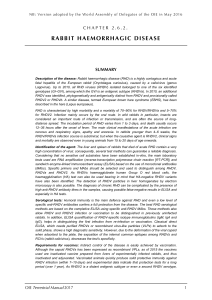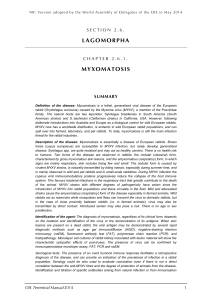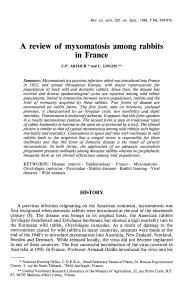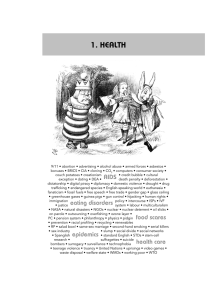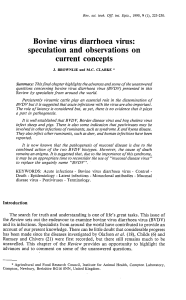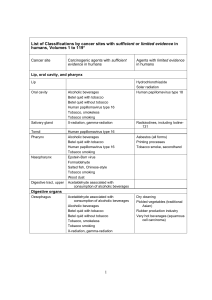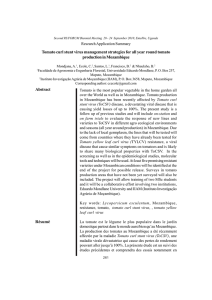Rabbit haemorrhagic disease: field epidemiology and the management of wild rabbit populations
publicité
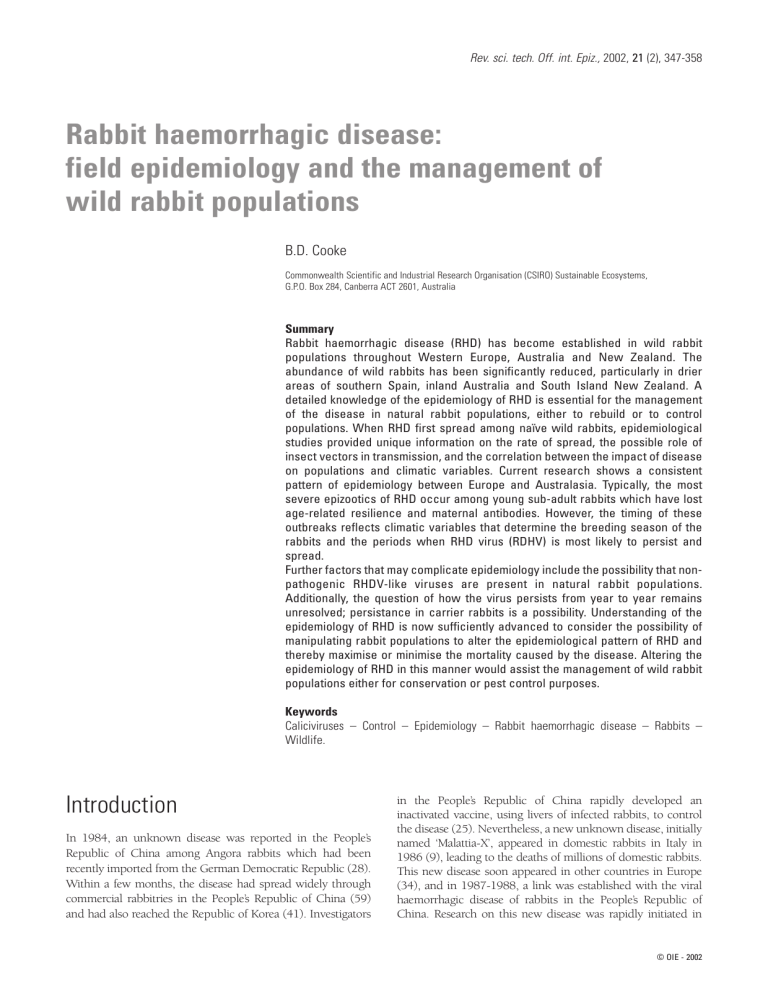
Rev. sci. tech. Off. int. Epiz., 2002, 21 (2), 347-358 Rabbit haemorrhagic disease: field epidemiology and the management of wild rabbit populations B.D. Cooke Commonwealth Scientific and Industrial Research Organisation (CSIRO) Sustainable Ecosystems, G.P.O. Box 284, Canberra ACT 2601, Australia Summary Rabbit haemorrhagic disease (RHD) has become established in wild rabbit populations throughout Western Europe, Australia and New Zealand. The abundance of wild rabbits has been significantly reduced, particularly in drier areas of southern Spain, inland Australia and South Island New Zealand. A detailed knowledge of the epidemiology of RHD is essential for the management of the disease in natural rabbit populations, either to rebuild or to control populations. When RHD first spread among naïve wild rabbits, epidemiological studies provided unique information on the rate of spread, the possible role of insect vectors in transmission, and the correlation between the impact of disease on populations and climatic variables. Current research shows a consistent pattern of epidemiology between Europe and Australasia. Typically, the most severe epizootics of RHD occur among young sub-adult rabbits which have lost age-related resilience and maternal antibodies. However, the timing of these outbreaks reflects climatic variables that determine the breeding season of the rabbits and the periods when RHD virus (RDHV) is most likely to persist and spread. Further factors that may complicate epidemiology include the possibility that nonpathogenic RHDV-like viruses are present in natural rabbit populations. Additionally, the question of how the virus persists from year to year remains unresolved; persistance in carrier rabbits is a possibility. Understanding of the epidemiology of RHD is now sufficiently advanced to consider the possibility of manipulating rabbit populations to alter the epidemiological pattern of RHD and thereby maximise or minimise the mortality caused by the disease. Altering the epidemiology of RHD in this manner would assist the management of wild rabbit populations either for conservation or pest control purposes. Keywords Caliciviruses – Control – Epidemiology – Rabbit haemorrhagic disease – Rabbits – Wildlife. Introduction In 1984, an unknown disease was reported in the People’s Republic of China among Angora rabbits which had been recently imported from the German Democratic Republic (28). Within a few months, the disease had spread widely through commercial rabbitries in the People’s Republic of China (59) and had also reached the Republic of Korea (41). Investigators in the People’s Republic of China rapidly developed an inactivated vaccine, using livers of infected rabbits, to control the disease (25). Nevertheless, a new unknown disease, initially named ‘Malattia-X’, appeared in domestic rabbits in Italy in 1986 (9), leading to the deaths of millions of domestic rabbits. This new disease soon appeared in other countries in Europe (34), and in 1987-1988, a link was established with the viral haemorrhagic disease of rabbits in the People’s Republic of China. Research on this new disease was rapidly initiated in © OIE - 2002 348 Europe, because of the commercial value of the rabbits for meat and fur production. Typically, rabbits died within 24 h-48 h of infection and showed few outward signs of disease, although bloody mucous discharge from the nose was occasionally observed. At necropsy, a discoloured liver, large spleen and small haemorrhages on the surface of organs such as the kidneys were apparent. Major haemorrhages were often found in the lungs, and the trachea showed hyperaemia and contained frothy blood-tinged mucous. The causative agent of the disease was subsequently established to be a calicivirus specific to the European rabbit (Oryctolagus cuniculus) (40). Similar to other caliciviruses, rabbit haemorrhagic disease virus (RHDV), as the agent has eventually become known, was found to be a non-enveloped ribonucleic acid (RNA) virus with an icosahedral capsid of 30 nm in diameter, comprised of 180 protein molecules. However, the arrangement of the genome differs from that of other groups of caliciviruses to the extent that the virus is now classified along with European brown hare syndrome virus in a separate group known as lagoviruses (23). By 1988, rabbit haemorrhagic disease (RHD) occurred not only in Europe, but had also been reported among domestic rabbits in the Russian Federation, in the Middle East and parts of Africa, and in Cuba, Mexico and India (34). The disease was almost certainly spread by trade in rabbit meat and fur, or by shipment of consignments of infected rabbits. In Europe, the virus rapidly spread from domestic to wild rabbits and was soon well established. The first cases of RHD in the wild were reported in Spain in June and July of 1988, and resulted in high mortality. Soon afterwards, the disease was reported in France (42). As the wild rabbit is an important game species in both countries, interest in the disease was intense. However, the spread of RHD also raised serious conservation concerns. The rabbit is an important element of Mediterranean shrubland ecosystems, both as a grazing animal and because rabbits support a number of endangered predators such as the Spanish lynx (Lynx pardina) and the imperial Eagle (Aquila adalberti). With the confirmation of RHD in wild rabbits in Scandinavia by January 1990 (47, 19) and in Great Britain by August 1994 (54), RHD had clearly become well established in wild rabbit populations throughout western Europe. The data on the spread of RHD are broadly supported by nucleotide differences in forty-four RHDV samples collected across Europe at this time (38). A phylogenetic tree based on those samples corresponds well, even though RHD in Spain and France appears to have originated from separate importations from the initial outbreak in Italy. The impact of RHD on wild rabbit populations in Europe was followed with great interest in Australia and New Zealand where wild rabbits had been introduced during the 19th © OIE - 2002 Rev. sci. tech. Off. int. Epiz., 21 (2) Century and were widely regarded as pests of agriculture and a threat to conservation of native plants and wildlife. In 1991, RHDV was imported into Australia and maintained in strict quarantine in the Australian Animal Health Laboratory while tests were performed to establish the safety and efficacy of the virus if used as a biological control agent. Included in this testing were host specificity trials which demonstrated that the virus caused no disease in any of the native mammals or birds tested (27). In 1995, more quarantined tests began on Wardang Island, off the coast of South Australia, to determine whether the virus would spread effectively among wild rabbits under the dry conditions typical of much of southern Australia. However, despite painstaking precautions to manage the quarantine facility (18), the virus demonstrated its pre-adaptation to the environment of Australia by spreading beyond the quarantine fences, crossing several kilometres of sea and rapidly spreading into dense rabbit populations in inland Australia. The escape from Wardang Island and the rapid initial spread of RHDV across the continent caused both amazement and alarm, but the virus has subsequently proved to be an extremely useful biological control agent against the introduced rabbit. Rabbit haemorrhagic disease has now been established in Australia for over six years and has substantially reduced the abundance of rabbits. Although the New Zealand Government maintained extensive interest and provided financial support for the investigations into the use of RHD for the biological control of rabbits in Australia, the authorities nevertheless decided not to use RHDV in New Zealand. However, farmers in areas where rabbits were a problem took the matter into their own hands. On 23 August 1997, RHD was confirmed on a farm in Central Otago on the South Island (53). Containment was attempted, but the virus was found to be present on many farms, and farmers were spreading the virus deliberately by treating carrot bait with homogenates of livers taken from rabbits which had died from the disease. In September 1997, the New Zealand Government agreed to legalise the use of RHDV for biological control and supplies of purified RHDV have since been made available for that purpose. This review discusses the principal results obtained from field epidemiological studies on wild rabbits undertaken in Europe, Australia and New Zealand. Information has been derived not only from the initial spread of the virus, but also from continuing field investigations and laboratory studies aimed at extending knowledge of the disease. However, by concentrating on the main epidemiological processes, a summary of information is provided which should form a basis for further management of RHD in rabbits, whether directed at rabbit conservation or population control. Rev. sci. tech. Off. int. Epiz., 21 (2) Initial spread of rabbit haemorrhagic disease in wild rabbits Europe In Europe, the initial spread of RHD to wild rabbits was linked so closely with the spread among commercial rabbitries that obtaining insights into epidemiology through unravelling the key factors involved is extremely unlikely. Disposal of waste from rabbitries and the use of fresh cut herbage to feed domestic rabbits no doubt provided routes for spreading RHDV in both directions between wild and captive rabbits. Nevertheless, observations in domestic rabbits clearly established the importance of transmission through direct contact and fomites, and seasonal patterns of epidemics were observed, indicating that climatic variables might be important. Exploration of the possibility of insect transmission revealed that flies of the genus Phormia transmitted the virus, with very few viral particles required to infect a rabbit via the conjunctiva (21). The involvement of seabirds in RHDV transmission in northern Europe was the subject of much conjecture (12, 20, 32), particularly when RHD appeared on off-shore islands. Once RHD became established in wild rabbit populations in Europe, a number of studies recorded the initial impact. An early outbreak was observed in the province of Almería in arid south-eastern Spain in June 1988 (46). Dead rabbits were present in such abundance that many were left untouched by scavengers (R. Soriguer and B.D. Cooke, unpublished data). Subsequent spread of the disease was well documented. In December 1988, the disease was detected in the province of Murcia, to the north of Almería. Serological studies performed at three-monthly intervals on live-captured rabbits revealed that many of the surviving rabbits, both adult and sub-adult, carried antibodies detectable by haemagglutination inhibition (HI) tests (L. León-Vizcaíno, personal communication). During the following year, confirmation was obtained that some very young rabbits carried antibodies against RHD, but these were considered to be temporary maternal antibodies because all subadults were seronegative. Nevertheless, the proportion of rabbits carrying antibodies declined as more and more young joined the adult population. By January 1990, no seropositive rabbits were found, but in May 1990, seropositive rabbits were again detected, indicating that a second disease outbreak had occurred. The spread of RHD across the province of Murcia was irregular, but a broad front could be recognised with the disease spreading at a rate of approximately 15 km per month. LeónVizcaíno (personal communication) took advantage of this irregularity to compare an RHD-affected rabbit population near Bullas with an RHD-free population nearby. Using transect 349 counts to follow changes in rabbit numbers and detect cadavers, the study showed that from mid-June to mid-July 1990, RHD reduced rabbit numbers by almost 50% in comparison with the uninfected site. Haemagglutination (HA) tests were used to confirm RHD in cadavers found in the affected area and HI tests were used to detect antibodies in those rabbits that survived. Neither dead rabbits nor rabbits with antibodies were detected on the control site. At approximately the same time, the spread of RHD was followed even further north through Alicante, an adjoining coastal province (43). Again RHD spread at approximately 15 km per month, from an outbreak in the south which began in the autumn of 1988 (October) and eventually merged with a second disease outbreak towards the north of the province. Not all rabbit populations were affected as the disease spread; some hunting reserves remained untouched. Furthermore, a sharp decline in disease activity occurred at the start of summer. The number of rabbits shot by hunters within the province declined between 1988 and 1989, but recovered to some extent in 1990. Counting rabbits along standardised transects demonstrated that on one site the peak counts in June each year fell from 21.1 rabbits/km in 1988 to 5.2 rabbits/km in 1989, then recovered to 21.2 rabbits/km in 1990. Following the initial outbreaks, less intensive, localised outbreaks of RHD occurred in the late winter (February-March) of 1990 and in the spring (April-May) of 1991 (V. Peiró, personal communication). Despite a relatively rapid transmission through Almería, Murcia and Alicante, RHD nevertheless took some years to reach all wild rabbit populations across the Iberian Peninsula. Even though RHD had already been reported from Portugal in 1989 (1), the initial spread of RHD through Doñana National Park in south-western Spain only occurred in March-May 1990. Radiocollars were fitted to rabbits to follow the spread of the disease in the national park and a death rate of 55% was recorded in adult rabbits with both sexes being equally affected. High temperatures in the area in late spring and summer were thought to have curtailed the epizootic. However, the epizootic of RHD at Doñana did not appear to be associated with seasonally high mosquito numbers and researchers concluded that vectors did not play a decisive role in transmission (55). Five years were required for RHD to reach most wild rabbit populations in Spain (51, 56). A similar picture was observed in France where the disease first appeared in 1989. Recurrent outbreaks of RHD soon occurred among wild rabbits in the Carmargue, Vaucluse and Hérault in the south of France (46) and the incidence of the disease was carefully monitored more broadly across France from 1994 onwards (2, 4, 33). However, not until 1995 was the first outbreak of RHD seen at the Chèvreloup arboretum, near Paris, among rabbits monitored since 1989 (31). The Chèvreloup rabbit population declined to 12% of the initial level over the course of a year. © OIE - 2002 350 The initial impact of RHD on wild rabbit populations in Europe appears to have been strongly influenced by geography and climate. The greatest recorded declines in rabbit abundance were in Spain, Portugal and France, whereas the virus reduced rabbit populations less severely in Great Britain and other countries of northern Europe. Spain is the only country where a major effort was made to assess the broad impact of RHD on rabbit populations (5). Hunters were interviewed to determine how rabbit numbers had changed since the arrival of RHD, then a nearby site with a rabbit population typical of the general area was visited and the assessments of post-RHD rabbit numbers as supplied by the hunters were standardised against quantitative field data. For each site, the relative rabbit density was estimated from sightings of rabbits and other signs such as warrens, diggings or dung along a 4-km transect. Data from 311 sites across Spain were compiled and climatic data, soil types and land use was also collated before considering the questionnaire results. Most hunters interviewed considered that the disease recurred annually with most outbreaks in winter or spring. It was concluded that, five years after the arrival of RHD, rabbit populations across Spain were being maintained at slightly less than 50% of their former levels. Nevertheless, some rabbit populations made better recoveries than others. In areas which were most favourable for rabbits, generally warmer sites with annual precipitation of approximately 450 mm-500 mm, rabbit numbers had a small but significant tendency to recover. However, in areas which were generally unfavourable to rabbits, populations had a strong propensity to remain low. Management of rabbit populations, often involving the control of predators, was also thought to be important in facilitating recovery of rabbit numbers. In contrast, RHD required a long time to become established in Great Britain and has an uneven distribution. Even before RHD became widespread (13), sera from wild rabbits throughout Great Britain reacted in HI tests that usually indicated antibodies to RHD. Twenty-two of these seropositive rabbits were challenged with virulent RHDV and all survived. Rabbits throughout France also carried antibodies which reacted in RHD enzyme-linked immunosorbent assays (ELISAs), even on islands where RHD had never been detected or suspected (32). The presence of these antibodies in Great Britain and France now seems explicable given the isolation of a non-pathogenic rabbit calicivirus (RCV) from domestic rabbits (11). Similar rabbit caliciviruses may well be present among wild rabbits, and arguably, these probably provided the precursors for RCV and virulent RHDV in domestic rabbits (18). Clearly, several possible explanations exist for the apparent differences between the impact of RHD in southern and northern Europe, and one possibility is the presence of a preexisting RHDV-like virus that effectively immunises rabbits © OIE - 2002 Rev. sci. tech. Off. int. Epiz., 21 (2) against virulent RHDV. This theory needs to be substantiated by isolation of the putative virus. Australia and New Zealand In contrast to the situation in Europe, the domestic rabbit industry in Australia is small and was not associated with the initial spread of RHDV. Furthermore, research into the epidemiology of RHD in wild rabbits was central for use of the virus as a biological control agent. Consequently, researchers were better prepared to monitor the spread of disease (14, 22) and considerably more information was gathered during the initial spread of RHD through the naïve rabbit population than was the case in Europe. Although pen-trials on Wardang Island were curtailed by the escape of the virus to the mainland, some important results were obtained, especially when viewed retrospectively. The disease did not spread as easily within natural warrens as had been imagined from small-scale laboratory trials. This was probably due to the precautionary removal of rabbit carcasses from experimental pens within 24 h of death. These were readily located and retrieved even from deep rabbit burrows using signals from the radio-collars fitted to each rabbit. Nevertheless, the highest rate of spread under experimental conditions was observed in June and July, the coolest months of the Southern Hemisphere winter, now regarded as an important time for field epizootics. By following the time between deaths of rabbits in experimentally infected populations and reintroducing rabbits into warrens formerly inhabited by infected rabbits, researchers established that infectious virus probably persisted in warrens for a relatively short time (i.e. several days rather than several weeks). Experimentally infected rabbits died on average 42 h after infection. None showed behavioural changes until approximately 12 h before death, and some cadavers retained fresh grass in their mouths indicating that they had been eating shortly before they died. All adult rabbits that were infected experimentally died and approximately 75% of cadavers were found below ground in the burrows. Insect vectors were of obvious interest in understanding the escape of the virus from the quarantine enclosure on Wardang Island, and bushflies (Musca vetustissima) and some of the larger blowflies (e.g. Caliphora dubia) were rapidly identified as potential mechanical vectors of the virus. Analysis of climatic data from the island and adjacent mainland was used to estimate times and directions of possible dispersal of the virus on insects (57). These estimates suggest that insects could have spread the virus from Wardang Island to the mainland under the weather conditions that prevailed between 12 and 14 October 1995. The trajectories of wind-borne insects in that period agree with the distribution of infected rabbits subsequently detected on the mainland (18). Many species of Rev. sci. tech. Off. int. Epiz., 21 (2) flies, mosquitoes and fleas readily become contaminated with RHDV in the field, and blowflies can retain virus in the gut for up to nine days after feeding on RHDV-infected rabbit liver. Furthermore, a single fresh fly-spot from these flies, containing an estimated 2-3 times the median lethal dose (LD50) of the virus, was sufficient to infect a rabbit, if ingested (3). Blowflies are not the only insects capable of transmitting RHDV; the rabbit fleas Spilopsyllus cuniculi and Xenopsylla cunicularis, and the mosquito Culex annulirostris can transmit RHDV under laboratory conditions (27). Data collected as RHD spread across mainland Australia provided further important insights into the likely epidemiology of the disease. Even in remote parts of Australia where deliberate human transfer was unlikely, RHDV spread far more rapidly than could be explained by rabbit to rabbit spread (26). Even the spread by predatory mammals such as foxes, known to excrete viable virus in their faeces after eating infected rabbits (50), provides an inadequate explanation. Again this indicated that flying insects were an important vector, at least during initial disease establishment. Data from Australia therefore point to a role for insects in the transmission of RHDV that was not apparent in the studies from Europe. Nevertheless, flies or mosquitoes might only be involved in occasional longdistance spread of the disease and contact transmission is probably the principal route of infection for maintaining RHD outbreaks in local populations. As implied from observations in Europe, the initial rate of spread of RHDV is also influenced by the season (52). In summer, few new disease foci were observed in comparison to those recorded from autumn or spring (26). Recurrence of RHD a year after the initial arrival of the disease also emphasised regional and seasonal patterns of mortality and differences in the efficacy of the disease between hot, dry areas and cool, wet areas. This may reflect differences in virus behaviour or survival because ambient temperature has no direct effect on the course of RHD in infected rabbits (15). Field studies in many localities across Australia revealed that regional differences in the impact of RHD persisted well after initial establishment of the disease. At some arid sites, rabbit numbers fell to less than 15% of former levels and have remained low (6, 16, 35). At other sites, the decline in rabbit numbers was more gradual, continuing over some years, while elsewhere, populations have recovered from an initial decline or apparently absorbed any mortality caused by RHD without any population change (49). Analysis of data from eighty-two sites across Australia, for which pre- and post-RHD transect counts of rabbits were available, showed that mortality caused by the disease was strongly influenced by climate (37). The initial impact of RHD 351 was higher in arid and semi-arid areas of inland Australia than in cooler humid regions of the Eastern Highlands and the coast. Subsequent principal component analysis of the same data can be interpreted as indicating that strong climatic components drive these regional variations in epidemiology (R. Henzell, personal communication). The initial impact of RHD appears to have been greatest in high-density populations once climatic variables are taken into account. Analysis of data relating to the deliberate release of RHDV as a biological control agent in New South Wales showed a strong association between the presence of heavy infestations of rabbit fleas (Spilopsyllus cuniculi), breeding in rabbits and RHD. Low temperatures also promoted outbreaks (30). In New Zealand, where RHDV was being deliberately transmitted on baits spread for rabbits to eat, comparisons were made between the epidemiology of RHD in a baited area and another site where the disease spread naturally (42). At the site where RHDV was deliberately spread, the death rate peaked three days after baits were spread. However, where the disease spread naturally, the peak death rate was observed at about twenty days, and some fresh carcasses were found for up to eighty days. According to estimates, on the site where RHD was deliberately spread, 66% of rabbits apparently died, 25% were challenged with RHDV but survived, and 9% apparently did not ingest infectious baits. Where the disease spread naturally, 66% of rabbits also died, 12% survived challenge and 22% did not become infected. The spread of RHDV in New Zealand was broadly monitored using serological tests of rabbit serum samples from thirteen sites, and a positive correlation was found between the survival rate of rabbits during epizootics and the subsequent levels of antibodies observed in the remaining rabbits. The widespread use of RHDV-contaminated baits, with little control of the viability or virulence of the virus, could have resulted in protective immunisation of some rabbits (39). The role of insect vectors, mainly blowflies (Calliphoridae) was also investigated in New Zealand (24). Although flies were considered to be likely vectors, no clear relationships existed which indicated any species as being of key importance. Interestingly, Lucilia sericata and Calliphora vicina, both introduced from Europe, were among the four species on which RHDV was regularly detected by reverse transcriptase polymerase chain reaction (RT-PCR). As observed in Europe, an increasing body of evidence suggests that other RHDV-like viruses were present in rabbit populations in Australia and New Zealand when RHDV first spread. Testing of rabbit sera collected from south-eastern Australia some years before the introduction of RHDV into Australia revealed that many rabbits appeared to have antibodies to a putative RHDVlike virus (44). Furthermore, recombinant virus-like particles © OIE - 2002 352 (rVLPs) expressed in baculovirus have been used in ELISAs to detect antibodies in sera collected from wild rabbits ahead of the arrival of RHD (36). This work not only demonstrated that many rabbits had pre-existing antibodies, but also provided evidence that high titres of those antibodies protected rabbits against fatal RHD. The fact that antibodies to the putative RHDV-like virus occur at higher titres in wet areas compared to dry regions of southern Australia (17), might offer one explanation for the reduced effectiveness of RHD in many high rainfall regions as the disease first spread. In New Zealand, rabbit sera collected before the spread of RHDV showed significant reactivity in competition ELISAs developed to detect RHDV antibodies (39). Nevertheless, although the pre-existing antibodies were widespread, up to 90% of wild rabbits died from RHD in some regions (29). Thus, the pre-existing antibodies may not have conferred significant protection against RHD. Epidemiology since initial establishment of rabbit haemorrhagic disease The initial spread of RHD through wild rabbit populations was a new phenomenon. Although some populations may have had protection from pre-existing antibodies produced by related, non-pathogenic viruses, many populations were essentially naïve and highly susceptible. Mortality rates were high especially among adult rabbits. Nevertheless, field data showed that young rabbits were less likely to die from infection than adults (55), a fact well known from investigations using laboratory rabbits. Approximately 40% of young rabbits between five and eight weeks of age survive experimental inoculation with RHDV, whereas only 10% of rabbits over nine weeks of age survive (34). Young rabbits also acquire protection against RHD in the form of maternal antibodies. Such antibodies were observed in Spain in early 1989, as soon as survivors from the first RHD outbreak resumed breeding (L. León-Vizcaíno, personal communication). The presence of maternal antibodies in wild rabbits has since been confirmed (16). In female rabbits previously exposed to RHDV, immunoglobulin G (IgG) antibodies are readily transferred to the young across the placenta, and antibody titres in late-stage embryos approximate those of the mother (B.D. Cooke, unpublished data). Without doubt, the best epidemiological study of RHD in wild rabbits in Europe was undertaken by C. Calvete and colleagues who worked in the semi-arid Ebro valley near Zaragoza in north-eastern Spain (7, 8). Using radio-tagged rabbits, the fate of individual rabbits was followed during successive outbreaks of RHD over four years. Epizootics of RHD generally lasted for © OIE - 2002 Rev. sci. tech. Off. int. Epiz., 21 (2) four to five weeks and occurred at variable times in the winter months from October to early March. By late spring (early May), the disease became less apparent. The disease spread unevenly through the population, affecting some social groups of rabbits but not others living in close proximity. Outbreaks early in the winter usually affected seronegative young adults and often lead to the death of suckling young as a consequence. Outbreaks later in the season principally affected juveniles which had lost age-related resilience and maternal antibody protection and an estimated 50% of juvenile rabbits died. Approximately 50% of the adult rabbit population carried antibodies against RHDV, although this percentage rose with the passage of disease through the population. Calvete and Estrada (8) recognised the importance of the resilience of kittens in epidemiology, whether age-related or acquired from the mother, in enabling rabbit populations to withstand RHD. These authors argued that mortality from RHD should increase with increasing population density, due to increased contact between rabbits. However, high population densities would also lead to a reduction in the median age at infection towards the age at which young rabbits still have agespecific or maternal antibody protection and can survive infection. This means that the effect of RHD on the population as a whole is reduced because sufficient numbers of young rabbits survive to maintain the basic breeding population. This would explain the current situation in Spain where some lowdensity rabbit populations show no sign of recovery while dense populations seem scarcely affected by RHD. This general model requires further testing. Nevertheless, field data from Australia appear to support the general pattern except that the epidemiological process occurs in sharply defined periods. This is because climatic factors not only cause variation in the rate of spread of the virus but also make rabbit breeding strongly seasonal. On this basis, it is possible that climatic factors which support high rabbit densities also directly influence other variables such as the timing and duration of rabbit breeding, and indirectly, the mortality caused by RHD. Epidemiological studies in Australia have benefited greatly from the use of ELISA methods developed in Italy for the veterinary diagnosis of RHD in domestic rabbits (10, 11). A good understanding of the serological changes associated with infection by RHDV has been achieved using ELISA to discern and quantify the antibody isotypes IgG, IgA and IgM (16). The data show that some rabbits may maintain traces of maternal antibodies in the field (exclusively IgG isotype) for at least twelve weeks. The protective effects of age-related resilience and maternal antibodies have been analysed experimentally (T. Robinson, personal communication), confirming that agespecific resilience lasts for approximately five weeks, but depending on the titre of the mother, maternal antibodies reduce the risk of mortality in older animals up to twelve weeks of age. Rev. sci. tech. Off. int. Epiz., 21 (2) Those rabbit kittens that survive RHD while protected by both age-specific resilience and maternal antibodies often show relatively low antibody titres. In contrast, rabbits which have lost all trace of maternal antibodies, but are lucky enough to survive infection as sub-adults, have IgG antibody titres approximately ten times higher. Rabbits with high antibody titre are also likely to respond more acutely on re-exposure to RHDV, particularly following oral re-exposure which produces a strong mucosal (IgA) response (B.D. Cooke and J. Merchant, unpublished findings). Antibody titres in rabbits which survive RHD generally decline with time following infection, but in the field, antibodies are frequently boosted as a result of re-expose to RHDV (16). Both IgG antibody isotypes and IgA isotypes increase and slowly build up in older rabbits. This potentially influences the levels of maternal antibodies in the progeny of rabbits repeatedly exposed to RHDV. Apart from age-related resilience to infection or protection afforded by maternal antibodies, young rabbits are also clearly less prone to infection with RHDV than adults. When RHD first escaped from experimental pens on Wardang Island, and began spreading through fully susceptible rabbits, a higher proportion of adult rabbits than young became infected. It has recently been demonstrated that RHDV binds to the common ABH antigens found on the surface of many mammalian cells (48). This explains why the agglutination of human red blood cells provides a basis for the common HA and HI tests used to detect RHDV and antibodies to RHDV. However, in the rabbit, these antigens are found on the mucosal cells of the gut and upper respiratory tract and only begin to become fully functional when the rabbits reach approximately six weeks of age. This pattern of development of mucosal ABH antigens has been confirmed from inner cheek swabs collected from wild rabbits in both France and Australia (J. Le Pendu, S. Marchandeau and B.D. Cooke, unpublished data). At Gum Creek in semi-arid South Australia, outbreaks of RHDV usually occur in autumn or early winter (May-July), around the time that rabbits begin breeding. Young adult rabbits which have lost maternal antibodies over the summer are principally affected and an estimated 87% of those affected die. Kittens from the first litters of the breeding season may also be affected at that time, although RHDV does not necessarily persist to affect siblings born later in the season. The spread of RHD among rabbit kittens appears to occur readily only when infected adults are present; the disease does not spread well amongst young rabbits alone. As a consequence, the late-born young lose the last of their maternal antibody protection and become fully susceptible by mid-summer, while virus activity remains low. However, these individuals are prime candidates for infection as the weather cools and the next breeding season begins. Recruitment into the adult breeding population at Gum Creek therefore depends heavily on the proportion of young rabbits 353 that contract RHDV when very young and are able to survive infection. Unless RHD occurs widely among young rabbits during spring (August-November) when over 80% of rabbits are born, too few young rabbits persist to maintain the breeding population. Although the Gum Creek rabbit population was reduced by over 90% when RHDV first spread in 1995 (35), the population has further declined over the last few years, to approximately three to four rabbits per spotlight km, as the immune adult population has dwindled for lack of recruitment. On the basis of the model by Calvete and Estrada (8), it could be argued that rabbit density in this location has fallen below the point at which the disease spreads sufficiently well to affect significant numbers of young rabbits. Nevertheless, the effects of season are difficult to separate in these interactions. Years of high rainfall might not only see an increase in rabbit breeding and rabbit density, but may also facilitate the persistence and spread of the virus. In a contrasting study, near Bacchus Marsh, Victoria, Australia (S. McPhee and B.D. Cooke, unpublished data), few seronegative rabbits are observed, the implication being that most must be exposed to RHDV while natural resilience and maternal antibodies are still present. However, interpretation of data from this population has the added complication that many rabbits have antibody profiles indicating that a putative RHDV-like virus is also widespread and may provide even greater protection against RHDV. The Bacchus Marsh population declined by only 40% when RHD arrived in 1996, but the rabbit population rapidly recovered and has since maintained itself at a relatively high density, as judged from night-time counts (approximately fifty rabbits per spotlight km). Rabbit haemorrhagic disease virus clearly persists from year to year, although the mechanism for this persistence is not fully understood. In some populations, despite sharp outbreaks occurring in mid-winter, sporadic cases of RHD can be observed among sub-adult rabbits at almost any time. Furthermore, the virus is known to persist for at least three weeks in carcasses (58), thus the regular recurrence of disease as breeding begins may indicate the persistence of virus in cadavers which are disturbed as nesting chambers are renovated (8). Nevertheless, contact between susceptible rabbits and cadavers is probably not confined to such situations, and it has been argued that some rabbits may act as carriers of RHDV and that under stressful conditions, virulent virus might be shed (7, 30). Indeed, both viral RNA and the 60-kDa coat protein from RHDV are recoverable from wild rabbits which have previously been exposed to RHDV (C. Musso and I. Lugton, personal communication). This RNA and viral protein has been detected in tonsils, Peyer’s patches and the blood. Nevertheless, observations reveal that in some rabbit populations RHD does not occur each year. This suggests that carriers of virus may readily shed virus only under severe stress, or that effective carriers are not commonly found. Movement of rabbits or vectors may also be necessary to maintain RHD. © OIE - 2002 354 Rev. sci. tech. Off. int. Epiz., 21 (2) Further research In addition to considering the interesting possibility that RHDV may be a persistent virus in some rabbits, further research should be undertaken regarding matters of more immediate practical interest. In particular, confirmation of the existence of the putative RHDV-like viruses is important; isolation and experimental demonstration of transmissibility should be performed. Furthermore, studies should confirm whether antibodies to these putative RHDV-like viruses can protect rabbits against severe RHDV infection. For management of rabbits in Australia and New Zealand, this would provide a basis for developing a strategy for enhancing the impact of RHDV in areas of high rainfall. Field experiments should also be initiated to establish whether using conventional rabbit control methods might further enhance the effectiveness of RHDV or whether more virus could be released using baits for distribution at strategic times. Clearly, if rabbit density determines the outcome of RHDV outbreaks (8), then lowering rabbit numbers by poisoning and warren ripping would be a logical step towards making RHDV more effective. In wetter areas, RHDV alone has not always reduced rabbit numbers. Nonetheless, the virus may well prevent or retard the recovery of populations after other control methods have reduced numbers of rabbits. Possibly the most interesting aspect of investigations of RHD has been the consistency of patterns of epidemiology observed in Europe and in Australia. Some clear parallels exist, in that RHD has had a greater impact on rabbits in arid areas than in cooler, more humid regions. The underlying pattern of RHD epizootics in arid areas of Spain and Australia, where the disease principally occurs among young adults in autumn or winter, is also striking. These factors suggest that a very precise description of RHD is likely to be obtained when all current field studies are finally reported. In conclusion, RHD appears set to become one of the better described viral diseases of the wild rabbit, rivalling myxomatosis in terms of the understanding of the epidemiology of the disease. This should provide useful comparative information for considering the two diseases as interacting pathogens and following the co-evolution of the diseases with the rabbit. Equally importantly, significant insights should be obtained into the epidemiology of other caliciviruses of veterinary or medical importance. In Europe, enhancement of rabbit populations by management of predators, re-stocking of areas where rabbits have declined, or immunising rabbits to enhance the breeding population should arguably be obvious objectives. The approach appears feasible given the hypothesis that dense rabbit populations can maintain themselves. ■ Maladie hémorragique du lapin : épidémiologie de terrain et gestion des populations sauvages de lapins B.D. Cooke Résumé La maladie hémorragique du lapin s’est établie parmi les populations de lapins sauvages d’Europe occidentale, d’Australie et de Nouvelle-Zélande. Le nombre de lapins sauvages a de ce fait considérablement diminué, surtout dans les régions arides d’Espagne, à l’intérieur des terres en Australie et dans l’île du Sud de Nouvelle-Zélande. Une connaissance approfondie de l’épidémiologie de cette maladie est indispensable pour mieux la maîtriser chez les lapins sauvages, que ce soit à des fins de repeuplement ou de contrôle des populations. Lorsque la maladie a atteint des populations de lapins sauvages précédemment indemnes, © OIE - 2002 355 Rev. sci. tech. Off. int. Epiz., 21 (2) les études épidémiologiques ont apporté de précieuses informations sur le rythme de la propagation, sur le rôle possible des insectes en tant que vecteurs ainsi que sur la corrélation entre l’impact de la maladie et les variables climatiques. Les recherches actuelles révèlent un même profil épidémiologique en Europe et en Australasie. De manière générale, les épizooties les plus graves de maladie hémorragique du lapin se produisent chez de jeunes animaux qui n’ont pas encore atteint l’âge adulte, ne possèdent plus d’anticorps maternels et ont perdu la faculté de récupération liée à l’âge. Cependant, l’apparition des foyers coïncide avec des variables climatiques qui déterminent la saison de la reproduction chez le lapin et favorisent les périodes de plus grande persistance et propagation du virus causal. D’autres facteurs sont susceptibles de compliquer l’épidémiologie de la maladie, notamment la possibilité que des virus non pathogènes similaires à celui de la maladie hémorragique du lapin soient présents dans les populations de lapins sauvages. De plus, la question de la survie du virus d’une année sur l’autre n’a toujours pas été élucidée, l’une des possibilités étant le portage asymptomatique. La compréhension de l’épidémiologie de la maladie hémorragique du lapin est désormais suffisamment avancée pour envisager de manipuler les populations de lapins afin de modifier le profil épidémiologique de la maladie et d’accentuer ou au contraire de réduire la mortalité qui lui est associée. Une telle modification de l’épidémiologie de la maladie hémorragique du lapin pourrait permettre une meilleure gestion des populations de lapins sauvages, à des fins de conservation de l’espèce ou de lutte contre les nuisibles. Mots-clés Calicivirus – Épidémiologie – Faune sauvage – Lapins – Maladie hémorragique du lapin – Prophylaxie. ■ Enfermedad hemorrágica del conejo: epidemiología sobre el terreno y gestión de las poblaciones de conejos salvajes B.D. Cooke Resumen La enfermedad hemorrágica del conejo se ha afianzado en poblaciones de conejos salvajes de Europa Occidental, Australia y Nueva Zelanda. El número de ejemplares salvajes ha experimentado un notable descenso, especialmente en las zonas secas del Sur de España, la Australia continental y la Isla del Sur de Nueva Zelanda. Para gestionar la enfermedad en las poblaciones salvajes, ya sea con fines de repoblación o de control demográfico, es fundamental conocer en detalle su epidemiología. Cuando la enfermedad empezó a propagarse entre conejos salvajes no expuestos previamente a ella, los estudios epidemiológicos proporcionaron datos de gran valor sobre la dinámica de propagación, la posible intervención de insectos como vectores de transmisión y la correlación entre una serie de variables climáticas y la incidencia de la enfermedad en las poblaciones. Las investigaciones actuales ponen de manifiesto un mismo patrón epidemiológico en Europa y Australasia. Por regla general, las epizootias más devastadoras se registran entre jóvenes subadultos que han perdido los anticuerpos maternos y el poder de recuperación ligado a la edad. Sin embargo, la pauta temporal de esos brotes traduce variables climáticas que determinan la © OIE - 2002 356 Rev. sci. tech. Off. int. Epiz., 21 (2) época de cría de los conejos y los periodos en que el virus de la enfermedad tiene más probabilidades de persistir y extenderse. Hay otros factores que pueden complicar la epidemiología, como la posibilidad de que las poblaciones de conejos salvajes alberguen virus no patógenos afines al agente etiológico de la enfermedad. Queda por desentrañar además la forma en que el virus logra persistir de un año al siguiente, aunque se sabe que quizá lo haga en el interior de conejos portadores. Hoy en día se conoce suficientemente la epidemiología de la enfermedad como para considerar la posibilidad de manipular poblaciones de conejos para modificar las pautas epidemiológicas y maximizar o minimizar así la mortalidad causada por la enfermedad. Ello ayudaría a gestionar las poblaciones de conejos salvajes, ya fuera con la idea de protegerlas o de luchar contra la plaga en que a veces se convierten. Palabras clave Calicivirus – Conejo – Control – Enfermedad hemorrágica del conejo – Epidemiología – Fauna salvaje. ■ References 1. Anon. (1989). – Doença hemorrágica a vírus do coelho em Portugal. Rev. port. Ciênc. vet., LXXXIV (489), 57-58. 2. Artois M., Lamarque F., Barrat J. & Berny P. (1997). – Bilan de la surveillance sanitaire de la faune sauvage en 1995. Bull. mens. Off. nat. Chasse, 221, 24-35. 3. Asgari S., Hardy J.R.E., Sinclair R.G. & Cooke B.D. (1998). – Field evidence of mechanical transmission of rabbit haemorrhagic disease (HDV) by flies (Diptera: Calliphoridae) among wild rabbits in Australia. Virus Res., 54, 123-132. 4. Barrat J., Gérard Y., Artois M., Lamarque F. & Berny P. (1996). – Bilan de la surveillance sanitaire de la faune sauvage en 1994. Bull. mens. Off. nat. Chasse, 210, 18-25. 5. Blanco J.C. & Villafuerte R. (1994). – Factores ecológicos que influyen sobre las poblaciones de conejos. Incidencia de la enfermedad hemorrágica. Informe técnico. Empresa de Transformación Agraria, Madrid, 126 pp. 6. Bowen Z. & Read J. (1998). – Population and demographic patterns of rabbits (Oryctolagus cuniculus) at Roxby Downs in arid South Australia and the influence of rabbit haemorrhagic disease. Wildl. Res., 25, 655-662. 7. Calvete C., Estrada R., Villafuerte R., Osácar J.J. & Lucientes J. (1995). – Primeros resultados en campo sobre la enfermedad hemorrágica del conejo. Trofeo, 304, 22-28. 8. Calvete C. & Estrada R. (2000). – Epidemiología de enfermedad hemorrágica (VHD) y mixomatosis en el conejo silvestre en el valle medio del Ebro. Herramientas de gestión. Consejo de la Protección de la Naturaleza de Aragón, ARPIrelieve, SA, 175 pp. © OIE - 2002 9. Cancellotti F.M. & Renzi M. (1991). – Epidemiology and the current situation of viral haemorrhagic disease of rabbits and the European brown hare syndrome in Italy. In Viral haemorrhagic disease of rabbits and the European brown hare syndrome (J.-P. Morisse, ed.). Rev. sci. tech. Off. int. Epiz., 10 (2), 409-422. 10. Capucci L., Scicluna M.T. & Lavazza A. (1991). – Diagnosis of viral haemorrhagic disease of rabbits and the European brown hare syndrome. In Viral haemorrhagic disease of rabbits and the European brown hare syndrome (J.-P. Morisse, ed.). Rev. sci. tech. Off. int. Epiz., 10 (2), 347-370. 11. Capucci L., Fusi P., Lavazza A., Pacciarini M.L. & Rossi C. (1996). – Detection and preliminary characterisation of a new calicivirus related to rabbit haemorrhagic disease but non-pathogenic. J. Virol., 70, 8614-8623. 12. Chasey D. (1994). – Possible origin of rabbit haemorrhagic disease in the United Kingdom. Vet. Rec., 135, 496-499. 13. Chasey D., Trout R.C. & Edwards S. (1997). – Susceptibility of wild rabbits (Oryctolagus cuniculus) in the United Kingdom to rabbit haemorrhagic disease (RHD). Vet. Res., 28, 271-276. 14. Collins B.J., White J.R., Lenghaus C., Morrissy C.J. & Westbury H.A. (1996). – Presence of rabbit haemorrhagic disease virus in rabbit tissues as revealed by monoclonal antibody dependent capture ELISA. J. virol. Meth., 58, 145154. 15. Cooke B.D. & Berman D. (2000). – Effect of inoculation route and ambient temperature on the survival time of rabbits, Oryctolagus cuniculus (L.), infected with rabbit haemorrhagic disease virus. Wildl. Res., 27, 137-142. Rev. sci. tech. Off. int. Epiz., 21 (2) 16. Cooke B.D., Robinson A.J., Merchant J.C., Nardin A. & Capucci L. (2000). – Use of ELISAs in field studies of rabbit haemorrhagic disease (RHD) in Australia. Epidemiol. Infect., 124, 563-576. 17. Cooke B.D., McPhee S., Robinson A.C. & Capucci L. (2002). – Rabbit haemorrhagic disease: does an RHDV-like virus reduce the effectiveness of RHD as a biological control agent in Australia? Wildl. Res. (in press). 18. Fenner F. & Fantini B. (1999). – Biological control of vertebrate pests. The history of myxomatosis – an experiment in evolution. CABI Publishing, Wallingford, 339 pp. 19. Gavier-Widen D. & Mörner T. (1991). – Epidemiology and diagnosis of the European brown hare syndrome in Scandinavian countries: a review. In Viral haemorrhagic disease of rabbits and the European brown hare syndrome (J.-P. Morisse, ed.). Rev. sci. tech. Off. int. Epiz., 10 (2), 453-458. 20. Gavier-Widen D. & Mörner T. (1993). – Descriptive epizootiological study of European brown hare syndrome virus in Sweden. J. Wildl. Dis., 29, 15-20. 21. Gehrman B. & Kretzschmar C. (1991). – Ein Experimenteller beitrag zur Epizootiologie der Viralen Hämorrhagishen Septikämie der Kaninchen (Rabbit Haemorrhagic Disease, RHD) – Übertragung durch Fliegen. Berl. Münch. tierärztl. Wochenschr., 104, 192-194. 22. Gould A.R., Kattenbelt J.A., Lenghaus C. & Morrissy C.J. (1997). – The complete nucleotide sequence of rabbit haemorrhagic disease virus (Czechoslovakian strain v315). Use of polymerase chain reaction to detect replication in Australian vertebrates and analysis of viral population sequence data. Virus Res., 47, 7-17. 23. Green K.Y., Ando T., Balayan M.S., Berke T.S., Clarke I.N., Estes M.K., Matson D.O., Nakata S., Neill J.D., Studdert M.J. & Thiel H.-J. (2000). – Taxonomy of the Caliciviruses. J. infect. Dis., 181 (Suppl. 2), 322-330. 24. Heath A.C.G., Heyward R. & Norbury G. (1998). – Blowflies (Calliphoridae) as potential vectors of rabbit haemorrhagic disease in New Zealand. In Proc. rabbit control, RCD: dilemmas and implications conference, 30-31 March, Wellington, New Zealand. Roy. Soc. N.Z. Misc. Series, 55, 8588. 25. Huang H.-B. (1991). – Vaccination against the immune response to viral haemorrhagic disease of rabbits: a review of research in the people’s Republic of China. In Viral haemorrhagic disease of rabbits and the European brown hare syndrome (J.-P. Morisse, ed.). Rev. sci. tech. Off. int. Epiz., 10 (2), 337-345. 26. Kovaliski J. (1998). – Monitoring the spread of rabbit haemorrhagic disease virus as a new biological agent for the control of European rabbits in Australia. J. Wildl. Dis., 34, 421-428. 27. Lenghaus C., Westbury H., Collins B., Ratnamohan M. & Morrissy C. (1994). – Overview of the RHD project in Australia. In Rabbit haemorrhagic disease: issues for assessment for biological control (R.K. Munro & R.T. Williams, eds). Australian Government Printing Service, Canberra, 104-129. 357 28. Liu S.J., Xue H.P., Pu B.Q. & Quian N.H. (1984). – A new viral disease in rabbits [in Chinese]. Anim. Husb. Vet. Med., 16, 253-255. Abstract in Vet. Bull., 55 (5600), 1985. 29. Lough R.S. (2000). – Serological survey of feral rabbit populations in New Zealand before the arrival of rabbit haemorrhagic disease. Otago Regional Council, Otago, 22 pp. 30. Lugton I.W. (1999). – A cross-sectional study of risk factors affecting the outcome of rabbit haemorrhagic virus releases in New South Wales. Aust. vet. J., 77, 322-328. 31. Marchandeau S., Chantal J., Portejoie Y., Barraud S. & Chaval Y. (1998). – Impact of viral haemorrhagic disease on a wild rabbit population in France. J. Wildl. Dis., 34, 429-435. 32. Marchandeau S., Ricci J.C. & Chantal J. (1998). – Taux de prévalence sérologique du virus de la maladie virale hémorragique (VHD) du lapin de garenne (Oryctolagus cuniculus) et de ses formes apparentées au sein de différentes populations sauvages en France. Mammalia, 62, 95-103. 33. Marchandeau S. & Boucraut-Baralon C. (1999). – Épidémiologie de la myxomatose et des caliciviroses apparentées à la VHD dans une population sauvage de lapins de garenne (Oryctolagus cuniculus). Gibier Faune sauv., Game Wildl. Sci., 16, 65-80. 34. Morrisse J.-P., Le Gall G. & Boilletot E. (1991). – Hepatitis of viral origin in Leporidae: introduction and aetiological hypothesis. In Viral haemorrhagic disease of rabbits and the European brown hare syndrome (J.-P. Morisse, ed.). Rev. sci. tech. Off. int. Epiz., 10 (2), 283-295. 35. Mutze G., Cooke B. & Alexander P. (1998). – Initial impact of rabbit haemorrhagic disease on European rabbit populations in South Australia. J. Wildl. Dis., 34, 221-227. 36. Nagesha H.S., McColl K.A., Collins B.J., Morrissy C.J., Wang L.F. & Westbury H.A. (2000). – The presence of cross-reactive antibodies to rabbit haemorrhagic disease virus in Australian wild rabbits prior to the escape of the virus from quarantine. Arch. Virol., 145, 749-757. 37. Neave H.M. (1999). – Rabbit calicivirus disease program report 1: overview of effects on Australian wild rabbit populations and implications for Agriculture and Biodiversity. Bureau of Rural Sciences, Canberra, 47 pp. 38. Nowotny N., Ros Boscuñana C., Ballagi-Pordány A., GavierWidén D., Uhlén M. & Belák S. (1997). – Phylogenetic analysis of rabbit haemorrhagic disease and European brown hare syndrome viruses by comparison of sequences from the capsid protein gene. Arch. Virol., 142, 657-673. 39. O’Keefe J.S., Tempero J.E., Motha M.X.J., Hansen M.F. & Atkinsona P.H. (1999). – Serology of rabbit haemorrhagic disease virus in wild rabbits before and after the release of the virus in New Zealand. Vet. Microbiol., 66, 29-40. 40. Olinger V.F. & Thiel H.-J. (1991). – Identification of the viral haemorrhagic disease virus of rabbits as a calicivirus. In Viral haemorrhagic disease of rabbits and the European brown hare syndrome (J.-P. Morisse, ed.). Rev. sci. tech. Off. int. Epiz., 10 (2), 311-323. © OIE - 2002 358 41. Park J.H., Kida H., Ueda K., Ochiai K., Goryo M. & Itakura C. (1991). – Etiology of rabbit haemorrhagic disease spontaneously occurring in Korea. J. vet. Med., B, 38, 749-754. 42. Parkes J.P., Norbury G. & Heyward R. (1998) – Initial epidemiology of rabbit haemorrhagic disease in New Zealand. In Proc. rabbit control, RCD: dilemmas and implications conference, 30-31 March, Wellington, New Zealand. Roy. Soc. N.Z. Misc. Series, 55, 80-83. 43. Peiró V. & Seva E. (1991). – Maladie hémorrhagique virale du lapin de garenne au sud-est de l’Espagne. In Proc. XXth Congress of the International Union of Game Biologists, 21-26 August, Godollo, Hungary. University of Agricultural Science, Godollo, Hungary, 752-758. 44. Robinson A.J., Kirkland P.D., Capucci L., Cooke B.D. & Philbey A.W. (2002). – The presence of a calicivirus in Australian wild rabbits Oryctolagus cuniculus prior to the introduction of rabbit haemorrhagic disease virus (RHDV) influences the assessment of the specificity of a cELISA for RHDV. Wildl. Res., 29 (in press). 45. Robinson A.J., So P.T.M., Muller W.J., Cooke B. & Capucci L. (2002). – Statistical models for the effect of age and maternal antibodies on the development of rabbit haemorrhagic disease in wild rabbits. Wildl. Res., 29 (in press). 46. Rogers P.M., Arthur C.P. & Soriguer R.C. (1994). – The rabbit in continental Europe. In The European rabbit. The history and biology of a successful coloniser (H.V. Thompson & C.M. King, eds). Oxford University Press, Oxford, 22-63. 47. Rønsholt L., Dietz H.H., Lei J. & Henriksen P. (1990). – Rabbit viral haemorrhagic disease in Denmark (working paper). State Veterinary Institute, Kaldehave, 3 pp. 48. Ruvoen-Clouet N., Ganiere J.P., André-Fontaine G., Blanchard D. & LePendu J. (2000). – Binding of rabbit haemorrhagic disease virus to antigens of the ABH histo-blood group family. J. Virol., 74, 11950-11954. 49. Saunders G., Choquenot D., McIlroy J. & Packwood R. (1998). – Initial effects of rabbit haemorrhagic disease on freeliving rabbit (Oryctolagus cuniculus) populations in central western New South Wales. Wild. Res., 26, 69-74. 50. Simón M.C., Muguruza R., Alonso J.L., Muzquiz C., Girones O. & Haffar A. (1994). – Recherche du virus de la maladie hémorrhagique virale du lapin (RHD) chez le renard et rôle des canidés domestiques dans la transmission de la maladie. Rec. Méd. vét., 179, 841-845. © OIE - 2002 Rev. sci. tech. Off. int. Epiz., 21 (2) 51. Simón M.C., Ortega C., Maynar P., Muzquiz J.L., De Blas I., Muguruza R., Girones O., Alonso J.L. & Sanchez J. (1998). – Studies in wild rabbit (Oryctolagus cuniculus) populations in Navarra, Spain. I. Epidemiology of rabbit viral haemorrhagic disease. Gibier Faune sauv., Game Wildl. Sci., 15, 47-64. 52. Smyth R.E., Cooke B.D. & Newsome A.E. (1997). – The spread of rabbit calicivirus in relation to environmental factors. Resource Futures and Vertebrate Pests Programs, CSIRO Wildlife and Ecology, Canberra, 36 pp. 53. Thompson J. & Clarke G. (1997). – Rabbit calicivirus now established in New Zealand. Surveillance, 24, 5-6. 54. Trout R. (1998). – Results from field studies of rabbit haemorrhagic disease in Britain. In Proc. rabbit control, RCD: dilemmas and implications conference, 30-31 March, Wellington, New Zealand. Roy. Soc. N.Z. Misc. Series, 55, 6771. 55. Villafuerte R., Calvete C., Gortázar C. & Moreno S. (1994). – First epizootic of rabbit haemorrhagic disease in free-living populations of Oryctolagus cuniculus at Doñana National Park, Spain. J. Wildl. Dis., 30, 176-179. 56. Villafuerte R., Calvete C., Blanco J.C. & Lucientes J. (1995). – Incidence of viral haemorrhagic disease in wild rabbits in Spain. Mammalia, 59, 651-659. 57. Wardhaugh K. & Rochester W. (1996). – Wardang Island. A retrospective analysis of weather conditions in relation to insect activity and displacement. CSIRO Entomology, Canberra, 88 pp. 58. Westbury H. (1996). – Field evaluation of RCD under quarantine. Project CS.236, Australian and New Zealand Rabbit Calicivirus Research Program. Final Report. Meat Research Corporation, Sydney, 34 pp. 59. Xu W.-Y. (1991). – Viral haemorrhagic disease of rabbits in the People’s Republic of China: epidemiology and virus characterisation. In Viral haemorrhagic disease of rabbits and the European brown hare syndrome (J.-P. Morisse, ed.). Rev. sci. tech. Off. int. Epiz., 10 (2), 393-408.
